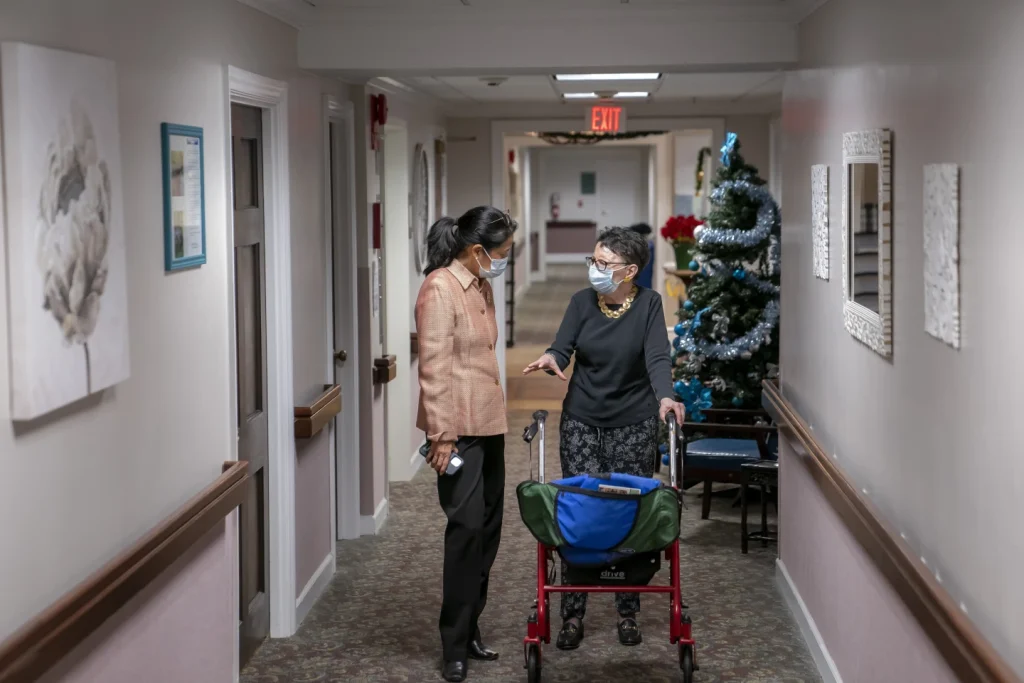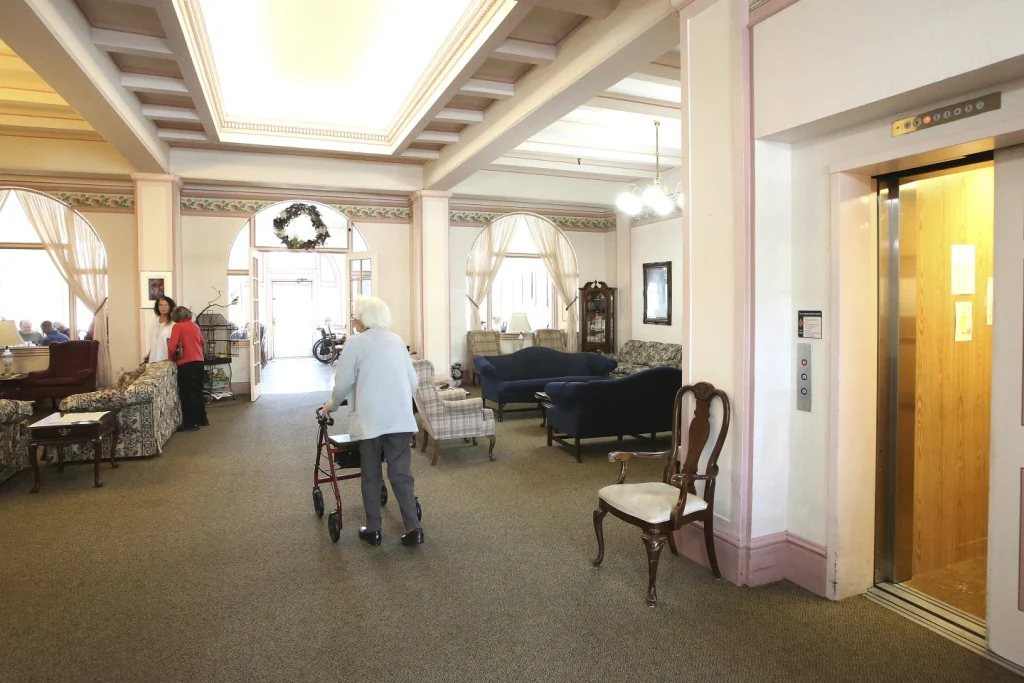In a groundbreaking announcement, the Biden administration revealed on Friday that the federal government will take the unprecedented step of dictating staffing levels at nursing homes.
This move comes as a direct response to the alarming systemic issues that were exposed by the devastating number of COVID-19 deaths in these facilities.
Advocates for older adults and individuals with disabilities have long been calling for such regulation, but the proposed threshold falls short of their expectations.
Consequently, it has not only drawn criticism from these advocates, but also from the nursing home industry itself, which argues that the mandate is unattainable.
The unveiling of this long-awaited promise, made with great fanfare during President Joe Biden’s 2022 State of the Union address, coincided with a holiday weekend, causing many Americans to divert their attention away from the news.
In a recent statement, Health Secretary Xavier Becerra emphasized the importance of establishing minimum staffing standards for nursing homes, highlighting the potential for improved resident safety.
Becerra firmly believes that when these facilities are understaffed, it is the residents who ultimately bear the brunt of the consequences.
By setting clear and enforceable guidelines regarding staffing levels, nursing homes can ensure that they have an adequate number of qualified healthcare professionals to meet the needs of their residents.
This would not only enhance the quality of care provided but also minimize the risks associated with understaffing, such as medication errors, delayed responses to emergencies, and compromised infection control measures.
The implementation of minimum staffing standards would undoubtedly be a significant step towards safeguarding the well-being and welfare of nursing home residents.
The proposed rules, which have now entered a public comment period and are expected to take several years to fully take effect, have generated significant attention and debate within the healthcare industry.
These rules aim to address the issue of staffing shortages in nursing homes by requiring a minimum staffing equivalent to 3 hours per resident per day, with registered nurses accounting for just over half an hour of that time.
Additionally, the rules stipulate that facilities must have a registered nurse on staff 24 hours a day, every day.
According to government reports, the average U.S. nursing home currently has an overall caregiver staffing level of approximately 3.6 hours per resident per day, with registered nurse staffing slightly surpassing the half-hour mark.
Despite this, the government argues that a majority of the country’s approximately 15,000 nursing homes, which collectively house around 1.2 million individuals, will still need to increase their staffing levels in order to comply with the proposed rules.
Chiquita Brooks-LaSure, the director of the Centers for Medicare and Medicaid Services (CMS), has described this move as “an important first step.” As the governing body responsible for overseeing nursing homes, CMS plays a crucial role in ensuring the well-being and quality of care provided to residents.
By implementing these new regulations, CMS aims to improve the overall standard of care in nursing homes and address the persistent staffing challenges faced by the industry.
However, the road to full implementation of these rules is expected to be lengthy and complex, as it involves a comprehensive review process and consideration of public feedback during the comment period.
A senior White House official, who spoke on the condition of anonymity prior to the official announcement, has indicated that the Biden administration is open to reconsidering the staffing threshold once it has been implemented.
Stacy Sanders, an aide to Beccera, emphasized that the current lack of a federal floor for nursing home staffing should not be seen as preferable to the proposed standards.
Sanders believes that the new standards would significantly increase staffing levels in over 75% of nursing homes, ensuring the presence of nurse aides at the bedside and guaranteeing the availability of a registered nurse on-site 24/7.
It is worth noting that these new thresholds are considerably lower than what advocates had long been advocating for, as a 2001 study funded by the Centers for Medicare and Medicaid Services recommended an average of 4.1 hours of nursing care per resident daily.
However, the majority of U.S. facilities currently fall short of meeting this threshold. Advocates argue that even this recommended level of care is inadequate, as it fails to consider the overall quality of life for residents and only focuses on the point at which potential harm may occur.
Initially, advocates were optimistic after the issue was highlighted by the Democratic president in his State of the Union speech, believing it would bring about the most significant change for nursing home residents since the Nursing Home Reform Act of 1987.
However, their optimism waned following the inadvertent release of a new CMS-funded study, which claimed that there is no clear threshold at which quality and safety are maximized.
The advocates who had been fervently supporting the cause were left feeling utterly disheartened and betrayed by the administration officials they believed to be their allies.
As news of the proposal spread on that fateful Friday morning, their disappointment turned into scathing criticism.
Richard Mollot, the leader of the Long Term Care Community Coalition, expressed his deep dissatisfaction, deeming the proposal “completely inadequate” and a missed opportunity of monumental proportions.
He argued that it disregarded any evidence of what the residents truly needed and failed to fulfill the core promise made by President Biden.
Though he reluctantly acknowledged that the 24/7 registered nurse requirement might bring marginal improvements to the most dire facilities, his overall assessment was scathing.
He lamented the decision, describing it as “heartbreaking” and “nauseating,” asserting that it would cause more harm than good.
He believed that endorsing poorly staffed nursing homes and potentially jeopardizing wrongful-death lawsuits would be detrimental.
In his eyes, it represented a grave dereliction of duty, allowing nursing homes to continue warehousing people and taking advantage of the public.
Katie Smith Sloan, the leader of LeadingAge, an organization representing nonprofit nursing homes, echoed these sentiments, deeming the rule meaningless in light of the industry’s existing workforce crisis.
She argued that there simply weren’t enough individuals available to hire, rendering the requirement futile.
The disappointment expressed by the speaker regarding President Biden’s decision to proceed with the proposed staffing ratios is an understatement, as it goes against clear evidence that opposes such ratios.
Currently, the law only requires that homes have “sufficient” staffing, leaving the interpretation of this term to the states.
However, the majority of states, thirty-eight in total along with the District of Columbia, have their own staffing regulations, some of which are so low that they are considered meaningless by advocates.
Furthermore, enforcement of these regulations is often ineffective. This issue has long been recognized by front-line nurse aides, who are typically low-paid, predominantly female, and disproportionately from minority backgrounds.
It is also evident to the residents themselves, who experience unanswered call bells, infrequent showers, and hunger due to the lack of assistance with meals.
The coronavirus pandemic, which tragically claimed the lives of over 167,000 nursing home residents in the United States, brought significant attention to the problem of poor staffing.
However, instead of improving, many nursing homes have experienced an even further decrease in staffing levels.
According to data from the Bureau of Labor Statistics, nursing homes currently have 218,200 fewer employees compared to February 2020, when the first outbreak of the coronavirus occurred in a nursing home near Seattle.
The American Health Care Association, widely recognized as the largest lobbyist advocating for nursing homes, has been engaged in an unyielding and persistent campaign, asserting that these facilities are on the brink of collapse.
They argue that Medicaid subsidies are inadequate, hiring and retention problems are widespread, and closures of nursing homes are rampant.
Moreover, they caution that implementing a staffing mandate would only serve to exacerbate these existing issues.
However, it is important to note that despite these claims, there have been no substantial indications of widespread closures within the nursing home industry.
Furthermore, the profitability of these homes has been consistently exposed, prompting critics to argue that if nursing homes simply offered better compensation, they would be able to attract and retain a more dedicated workforce.

We apologize for any confusion caused by the previous error in the article. It has come to our attention that the surname of the Long Term Care Community Coalition leader is Mollot, not Mollott.
We strive to maintain accuracy and integrity in our reporting, and we deeply regret any inconvenience or misinformation this may have caused.
It is our responsibility as journalists to ensure that the information we provide is reliable and factual. We have taken immediate action to rectify this mistake and have made the necessary corrections to accurately reflect the correct surname of the individual in question.
We appreciate your understanding and thank you for bringing this to our attention. Our commitment to delivering accurate and informative news remains paramount, and we will continue to uphold the highest standards of journalism in our future reporting.
